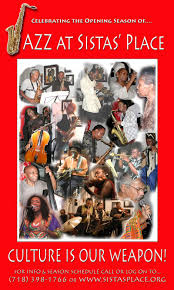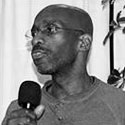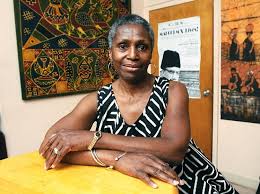
Several years ago as part of a jazz oral history project exploring the rich history of the music in Brooklyn’s historic Bedford-Stuyvesant community, I conducted a series of oral history interviews with friend and colleague Jennifer Scott for the Weeksville Heritage Center. For those not familiar with Weeksville it is the oldest African American community in Brooklyn. Three of those interviews focused on the vibrant alternative space for jazz known as Sista’s Place, located at 456 Nostrand Avenue at the corner of Jefferson Avenue. You can find Sista’s Place complete Saturday night jazz schedule at:http://sistasplace.org.
Trumpeter-composer Ahmed Abdullah, a veteran of the Sun Ra Arkestra and music director of Sista’s Place was the subject of our Pt. 1 interview in this ongoing series on alternative venues for jazz (scroll down for that one). This second part includes excerpts from our wide-ranging interviews with longtime political activists Roger Wareham and Viola Plummer. These two no-nonsense human rights activists were part of a NYC movement known as December 12, which begat Sista’s Place. Fittingly, as part of Sista’s Place’s Saturday, April 22 evening, Viola Plummer will be honored with the Jazz Journalist Association (JJA) Jazz Hero of Brooklyn award.
ROGER WAREHAM

In the whole development of your efforts through the December 12 movement, what have been your activities in the area of arts and culture?
Roger Wareham: Politically one of our slogans or mantras is that “culture is a weapon.” For every struggle for liberation one of the most important components, if not the most important component, is culture. And that takes many forms. I always remember a lecture that Amilcar Cabral, who led the liberation struggle in Guinea-Bissau gave in the Cape Verde islands; he started off the discussion talking about Goebbels, and how whenever the Nazis had a discussion and the issue of culture came up, Goebbels took out his gun and put it on the table because he was really clear that if you were going to suppress a people, to conquer them you had to destroy their culture. So we always saw culture as a key component for our struggle for liberation. So the theme of Sista’s Place is “culture is a weapon.” We opened up on September 23, 1995 on John Coltrane’s birthday; we start our [Sista’s Place jazz presenting] season around then and we’ve always had artists who reflect some degree of consciousness of the nature of our struggle.
So when we came here… our first music director was [saxophonist] Carlos Garnett, and certainly with [current Sista’s Place music director] Ahmed [Abdullah], I became aware about the places, and when the musicians started coming in and talking about the older [Brooklyn jazz] places, like the Blue Coronet and the different spots where people used to play [in Brooklyn], I became much more aware of the history [of jazz in Brooklyn]. I don’t know it chapter and verse, but I understand the richness of Brooklyn’s contribution to jazz and maybe more so than Harlem because a lot of folks who played there weren’t indigenous to Harlem, whereas a lot of folks emerged out of Brooklyn.
Our first spot [Sista’s Place] was on the corner of Jefferson and Nostrand. Jefferson begins at Claver Place, and Claver Place is where the East was, at 10 Claver Place. So you just walked from the East right up to Sista’s place, so its almost a geographic and physical part of that [East] legacy.
Many of the artists who have played [Sista’s Place] talk about the atmosphere when they play here, that they feel so comfortable they just enjoy playing. The artists are treated like royalty, they’re not background music for people’s discussions, people come here to hear the music. I remember when I was in college and I went to visit Cornell for some reason and we heard [poet-author] Don Lee reading – he hadn’t become Haki Madhabouti yet. I remember during his reading he had to stop at one point and tell [the audience] they had to shut up and listen because people were talking, it was disrespectful, and that was the first time I thought about that. People ought to respect the art, and so that’s what we do at Sista’s Place; the most important thing we have are the artists. We don’t always have the resources to pay them what they’re worth, but we always make sure we pay them what they agree to. Over time there have been a few grants that have helped out, but it’s really what walks in the doors that pay the artists.
Is Sista’s Place a not-for-profit?
RW: Yeah. And if not enough people walk through the door [artist fees] come out of our pockets. Like Abbey Lincoln said, ‘the artists gotta get paid’, so that’s our position. And I think the artists appreciate that, they know when they come here that they are treated and regarded as the important contributors and continuum of our culture.
What you’re saying about the artists’ perspective on a place like this – and there have been so few in this country – we got a good measure of that when we interviewed saxophonist (and Brooklyn resident) James Spaulding. He talked about playing at the East and playing at Sista’s Place. The first thing he talked about was looking out at a sea of faces that look like him. And he talked about the audience interaction. For him Sista’s Place felt much the same as playing at the East. This strikes me as a 21st century continuum of the whole idea behind the East. How would you compare the two?
RW: [James Spaulding is] great. I think it’s true. I went to the East a couple of times. The first time I saw Betty Carter, and the East was cultural nationalist with politics on the line and the whole atmosphere there was something that you immersed yourself in and you felt very comfortable, and it emerged out of the struggle of the 60s around black power, black nationalism, and black culture.
People come in [to Sista’s Place] and they feel almost like they’re listening to live music in their home. That’s what a lot of the artists say, that’s what people say, that ‘I feel at home here.’ We had a birthday celebration here for James Spaulding and he was so ecstatic. They performed and we had birthday cake and everything and the glee on his face was ecstatic, you can tell that he really enjoys playing here, and it is reciprocated – and that’s the continuation of the East. The performances here are a living interaction; the performers feed off the audience and the audience feeds off the performers.
Things have changed in a number of different ways since the East. Back then they established the place as purely for African Americans. That apparently isn’t the policy at Sista’s Place. Given the fact that Sista’s Place audiences are not exclusively black, does it still engender the same type of atmosphere?
RW: Yeah, because most of the time the white folks that come here are in the minority; this is not an organization or place where a minority can come here and dictate the atmosphere for the majority. And as long as folks don’t act rowdy, there’s not a problem. It helps pay the band. That’s not really an issue because the audience is predominantly black and we set the tone of what happens here. There are some [white] people who come here who are regulars and they’re real cool. Sometimes we get people who come here from abroad and there really haven’t been any problems.
Its gotta be a bit of a revelation for people who come here from abroad to experience a typical Sista’s Place audience, as opposed to going to some of the more traditional jazz clubs in Manhattan.
RW: Yeah, I guess for them it’s sort of like when they go to black churches on their tours. When we first started people would come here and say ‘oh, this place should be in the Village…’ Why can’t this place be in the black community in Brooklyn, why’s it gotta be in the Village?!? Why can’t we have this quality in our community? We charge $20-25 for what they charge $50 plus a minimum for at the Vanguard.
What is your jazz presenting season?
RW: Our season runs from Coltrane’s birthday (9/23) through the first or second weekend in June, then we shut down for the summer because there is so much stuff happening. But we usually do one or two shows during the summer. We open for the season on September 25. When we first opened I think it was Leon Thomas in ’95. Sista’s Place has become an institution in Brooklyn as a cultural spot. We’re going to continue it regardless of the intentions of the landlord or the powers that be; it is a continuation of a legacy of “culture as a weapon” that Brooklyn is famous for.
VIOLA PLUMMER

What was the decision behind determining that this place was going to have a real strong jazz presence?
VP: We thought that in this community, after the East was gone, after all the music places were gone… and remember, we had started that in Harlem with “Jazz Comes to Fight Back”, because we feel that it is jazz that really expresses, at least for us old people, our culture; it’s the music that grew out of struggle, that got interpreted, and that some of the brothers and sisters [jazz musicians] that are still alive didn’t play in our community, because there was no places to play when we started. I said the music I like best is jazz, so they called me the jazz policeman; I thought that was the music that was needed in our community.
When we were in the former location down the street, there was a brother who worked for the railroad who had three boys and he would bring them every night. Then there was another lady who has passed away, her nephew would come and they would be awestruck at how these brothers had conquered their instruments, and they would listen… they HEARD the music.
How is the audience at Sista’s Place different from the audiences at other places you’ve been?
VP: People come to hear the music, they experience the music, they understand what the music is saying, they celebrate the musicians… Other places I’ve been people pay their money and sit and talk and clink glasses and that kinda stuff… One night we had a fantastic band and there was a Chinese man who was visiting. I went up on the stage and he looked, I said CLAP… you didn’t like the music? So then everybody stood up and applauded. People really get into your being; say the sisters who are showing people to their seats, its like ‘we want to share this [music] with you.’ It’s something that is of great value to [the audience].
What’s the reaction from musicians who play here?
VP: Everyone says this is it, this is one of the best places they’ve ever played. Because #1 they get paid, #2 they appreciate that the people listen to their music and that we treat them like they’re artists, and like they’re contributing to our struggle, and then the way the audience responds to them.
I think Sista’s Place is wonderful, it has had the benefit of the history of the East; it has had the benefit of the coming together of jazz and poetry, and history… I think what Sista’s Place enabled us to do – the comrades that I worked with – it enabled us to meet people that they only read about. We do this thing for ‘Trane and people are so engrossed with the genius; and we did this thing for Miles, and now my grandchildren can now talk to me about some real music. Nobody gets paid here… we do it for the music; if we could just keep pushing this kind of network, it would be our path towards freedom.
Learn more about Sista’s Place, including their complete Saturday night jazz performance calendar here:http://sistasplace.org
